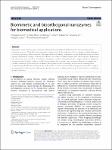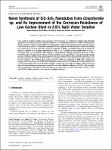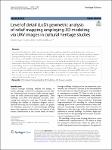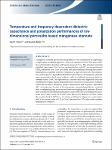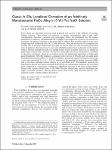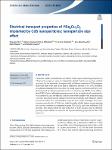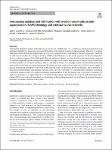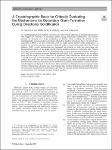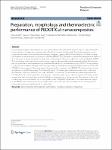Search
Author
- Osman, Ahmed I. (5)
- Daqing, Ma (3)
- Jorgensen, Ed (3)
- Li, Yan (3)
- next >
Subject
- kinh tế (26)
- Economics (12)
- programming (10)
- XRD (10)
- next >
Date issued
- 2020 - 2025 (2129)
- 2010 - 2019 (129)
- 2000 - 2009 (9)
- 1999 - 1999 (1)
Has File(s)
Search Results
Nanozymes mimic the function of enzymes, which drive essential intracellular chemical reactions that govern biological processes. They efficiently generate or degrade specific biomolecules that can initiate or inhibit biological processes, regulating cellular behaviors. Two approaches for utilizing nanozymes in intracellular chemistry have been reported. Biomimetic catalysis replicates the identical reactions of natural enzymes, and bioorthogonal catalysis enables chemistries inaccessible in cells. Various nanozymes based on nanomaterials and catalytic metals are employed to attain intended specific catalysis in cells either to mimic the enzymatic mechanism and kinetics or expand inaccessible chemistries. Each nanozyme approach has its own intrinsic advantages and limitations, makin... |
Coat synthesis of silicon carbide and composites of Si derivatives is a challenge for high-quality thin film applications, including corrosion resistance industries. A novel fabrication process of silicon carbide-silicon dioxide nanotube composites (SCDNTs) was developed by a solid reaction of silicon-carbon (marine sponge Cinachyrella sp.) resources. Trimetallic catalyst (Fe/Ni/Zr) supported on different Al2O3 media with heating in an argon flow was used to prepare SCDNTs composite. A higher crystallinity degree of the nanocomposites is attained at a heating temperature of 1200 °C as a suitable starting temperature to have a reasonable degree of crystallinity. XRD analysis of the prepared composite showed the presence of polycrystalline silicon dioxide and two phases of silicon car... |
Unmanned Aerial Vehicles (UAVs) are often preferred for modeling cultural heritage buildings due to their costs and time savings. The need for data collection, analysis, processing, and visual presentation in the context of cultural heritage buildings has become prominent, underscoring the significance of the concept of Level of Detail (LoD). The utilization of CityGML LoD standards enhances the performance of visual presentations, decreases the geometric complexity of objects, and enables users to view the model at the desired level of detail within a computerized environment. Within the scope of this study, it is aimed to determine the accuracy analysis of the 3D model for a cultural building, which is named Hekimbaşı Hunting Lodge, at different LoDs. |
Manganese stannate perovskite nanoparticles were synthesized by applying a complexation mediated approach. Rietveld refinement of the XRD data exhibited orthorhombic structure with space group of Pnma. The structure included eightfold coordinated Mn2+ cation, surrounded by eight O2− anions and formed MnO8 polyhedra unit. Each polyhedra unit interconnected through the corner-sharing SnO6 octahedra with the formation of a cage-like network. The temperature and frequency dependent dielectric performances of manganese stannate were measured in the form of a device, which exhibited maximum dielectric constant value ~ 3445. The high dielectric constant value was originated due to the contribution of space charge polarization and orientation polarization of dipoles within the measured freq... |
A flexible carbon fiber-confined yolk-shelled silicon-based composite is reported as an anode material for lithium storage applications. Silicon nanoparticles (Si NPs) are confined by the N-doped hollow carbon cages (Si-NHC) and these uniform dispersed yolk-shell-structured Si-NHC units were encapsulated by the carbon fibers within an interconnected three-dimensional (3D) framework (Si-NHC@CNFs). For the encapsulated yolk-shelled Si-NHC, the void space between the inner Si NPs and outer NHC can accommodate the structural changes of Si NPs during charging/discharging processes, leading to effectively improved structural stability and cycling life. More importantly, all the Si-NHC units were bridged together through a conductive CNFs “highway” to enhance the overall conductivity and t... |
Quasi-In Situ Localized Corrosion of an Additively Manufactured FeCo Alloy in 5 Wt Pct NaCl Solution FeCo alloys are important materials used in pumps and motors in the offshore oil and gas drilling industry. These alloys are subjected to marine environments with a high NaCl concentration, therefore, corrosion and catastrophic failure are anticipated. So, the surface dissolution of additively manufactured FeCo samples is investigated in a quasi-in situ manner, in particular, the pitting corrosion in 5.0 wt pct NaCl solution. The local dissolution of the same sample region is monitored after 24, 72, and 168 hours. Here, the formation of rectangular and circular pits of ultra-fine dimensions (less than 0.5 µm) is observed with increasing immersion time. In addition, the formation of a corrosion-inhibiting surface layer is detected on the sample surface. |
Electrical transport properties of YBa2Cu3Oy implanted by CdS nanoparticles nanoparticle size effect Cadmium sulfide nanoparticles size effects on the superconducting properties of YBa2Cu3Oy compound were investigated in details. Solid-state reaction method was used for the synthesis of samples with additional amounts of CdS nanoparticles with sizes 6 nm and 12 nm and an additional amount x = 0.1 wt%. Synthesis of cadmium nanoparticles was done by using aqueous methods and they were characterized by using transmission electron microscopy (TEM), X-ray diffraction (XRD). Optical absorption measurement of the as-synthesized nanoparticles was carried out, and the specific surface areas of the sample were analyzed using a surface area and porosity analyzer. Electrical resistivity and transport critical current densities were measured by using the four-probe technique. The measurements r... |
Anticipating qualitative changes in the rheological response of complex fluids (e.g., a gelation or vitrification transition) is an important capability for processing operations that utilize such materials in real-world environments. One class of complex fluids that exhibits distinct rheological states are soft glassy materials such as colloidal gels and clay dispersions, which can be well characterized by the soft glassy rheology (SGR) model. We first solve the model equations for the time-dependent, weakly nonlinear response of the SGR model. With this analytical solution, we show that the weak nonlinearities measured via medium amplitude parallel superposition (MAPS) rheology can be used to anticipate the rheological aging transitions in the linear response of soft glassy materi... |
A crystallography-based method is presented for the critical appraisal of possible mechanisms that trigger the formation of secondary grains during directional solidification. The method permits an analysis of a large population of defects, while avoiding the pitfalls of the metallographic sectioning approach that is affected by dendrite stereology. Here, the nickel-base superalloy CMSX-4, an alloy commonly used for single crystal turbine blade applications, is studied. All secondary grains originate exclusively at the external surface and when the off-axial primary ⟨001⟩
crystal orientations are measured, are evident at both the converging and diverging dispositions of the single crystal primary dendrites without a noticeable bias. Almost all of the secondary grains have low miso... |
Incorporating inorganic nanomaterials into a polymer matrix is one of the most effective ways to create thermoelectric performance for applications where physical flexibility is essential. In this study, flexible thermoelectric nanocomposite films were synthesized by incorporating inorganic copper iodide (CuI) nanosheets as the filler into poly (3,4-ethylene dioxythiophene): poly (styrene sulfonate) (PEDOT: PSS). The process involved the preparation of bulk CuI from precursors and, subsequently, the nanosheet synthesis by dissolving the bulk CuI in dimethyl sulfoxide (DMSO). The morphology of the nanosheets and the nanocomposite films was thoroughly examined, and the film’s thermoelectric performance was evaluated using a standard thermoelectric measurement system, ZEM-3. |

